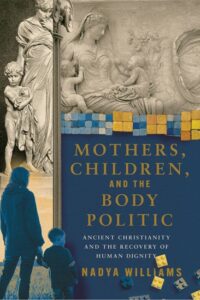Around this time last year, I was teaching Zora Neale Hurston’s Their Eyes Were Watching God to high school juniors taking American literature. “Janie is such a Charlotte,” a female student told me. She was describing the novel’s protagonist, who is always jumping around from husband to husband, preferring a bad relationship to being alone. “‘Charlotte is like in Sex and the City,” she clarified. “Have you seen that?” I hadn’t, actually, since it had originally aired when I was a child. I had noticed it had come to Netflix, though, so I decided to give it a watch. If my 17-year-old students had seen it, so could I.
Or so I thought. I’m not particularly squeamish, nor am I much of a moralizer when it comes to art—Lolita happens to be one of my favorite novels—but there is a surprising cruelty to Sex and the City. The show is needlessly graphic, to the point of obscenity. I suppose I shouldn’t have been surprised. Still, it horrified me that these were the messages my students were internalizing: that being an adult woman means drinking bottomless cosmopolitans, using nameless, faceless strangers for orgasms, enduring heartbreak after heartbreak until maybe, after enough exhaustion, you might be given a ring.
I was my students’ age not terribly long ago. That was back in 2017, when #MeToo broke out. It initially seemed to me a righteous cause, though I didn’t really understand it (how could I have?). I began to turn against it in college—right around when I began to turn against extended COVID mandates. Perhaps #MeToo was part of some slate of progressive lies du jour that had done more harm than good, a series of witch hunts masquerading as righteousness. Clearly, I wasn’t alone in feeling as I was. #MeToo is now being broadly reevaluated—as evidenced by developments like Andrew Cuomo’s running for office again and due process returning to campus.
It would be ludicrous to insinuate that the experiences of the Sex and the City crew were somehow representative of normal women in the 1990s and 2000s. Still, in retrospect, the overt degeneracy of the show—as well as that of the “lighter” hook-up culture on shows like Friends or Seinfeld and the general raunch culture of the 2000s—clearly demonstrates why #MeToo happened in the first place. A society that tore down every time-tested, reasonable boundary—thereby rendering every sexual encounter short of back-alley rape morally permissible—was a society doomed to erect new, unreasonable boundaries.
Ultimately, #MeToo was a failed attempt to restore sanctity to sex, a cultural-wide reaction to a deeply uncomfortable realization: declaring every sexual encounter morally permissible did not make it so.
Sex Positivity
Before #MeToo came sex positivity. One of the people who did the most to popularize it was Laci Green, a YouTuber who ran a channel called Sex+. Green had accumulated over one million subscribers by 2014 by publishing videos like “WRAP YOUR JUNK BEFORE YOU BUMP,” “Laci’s Guide to Booty Stuff,” and “BDSM 101.” The premise of her show, as the titles indicate, was to make the sacred profane. This, of course, was not revolutionary. What made Green and other sex educators of her era different was their insistence that liberated conceptions of sexuality be codified, almost bureaucratized. Sex was made mundane, yet simultaneously treated as so important that it needed to be taught to everyone of all ages.
For Green, every sexual orientation and every sexual kink was perfectly acceptable. There was only one rule: “Consent isn’t just hot,” she said in a 2014 video, “it’s also mandatory. Sexual contact without consent is assault or rape.”
In a narrow sense, this is logically coherent. But Green went beyond this narrow sense, defining drunk sex as categorically rape, as did many of the feminists of her time. Presumably, this would include a married woman who consented to having drunken sex with her husband before she was drinking, as well as a mutually drunken couple who both want to have sex. It was also unclear exactly how much alcohol was necessary for consent to become impossible. Did this happen at certain blood alcohol level? A certain number of drinks? A single sip? The lines drawn at the time by third-wave feminists were clearly arbitrary, yet they formed a de facto progressive sex manual that spread to young women around the internet. Its teachings were clear: all sexual behavior was morally permissible, so long as both parties agreed to whatever it was that they were doing, and so long as both parties were capable of agreeing.
Yet this was clearly unsatisfying. Even as the sex positivity movement grew in size, scope, and influence—and even as the Obama administration favored those (mostly women) alleging sexual assault in campus Title IX cases—there was a demand for more: more rules, more bureaucracies, more people and institutions telling young people what to do.
Hundreds of Princeton students, for instance, held a sit-in in 2019 because they wanted administrators to do more to protect alleged victims on campus. When the Atlantic’s Colin Friedersdorf asked them why they wanted the formalization of a gender and sexuality studies department, the protesting students wrote, “To acknowledge that gender and sexuality impacts the way we move through the world is not a political statement… The departmentalization of Gender and Sexuality Studies will help generate research on gender and sexual violence on campus and provide intellectual frameworks to help combat those forms of violence.”
For all their rejection of organized religion, these students were essentially seeking a kind of theological pronouncement concerning what is considered by essentially every world religion a sacred mystery.
The Tide Turns
The initial allegations against men like Harvey Weinstein and Bill Cosby were of outright rape and sexual coercion. The subsequent allegations were of molestation and behavior that, while not quite reaching the sheer depravity of outright rape, was nevertheless degenerate and awful. Think, for example, of Louis C.K., who was accused of masturbating in front of his female colleagues, and who later issued a public apology to the women he wronged.
But as the #MeToo revolution progressed, the line between a sexual assault and a bad sexual encounter became more and more fuzzy. The turning point was a January 2018 allegation against Aziz Ansari published at the feminist website Babe. This story involved neither rape nor coercion: she went to his place, they kissed, she didn’t like the way he kissed, he tried to have sex with her, she said no, he stopped, he called her an Uber, she left. It wasn’t exactly clear what the woman was even accusing him of, although it was framed as a #MeToo story. Bari Weiss, then at the New York Times, wrote a column titled, “Aziz Ansari Is Guilty. Of Not Being a Mind Reader.” #MeToo, for Weiss, had devolved into an “insidious attempt by some women to criminalize awkward, gross and entitled sex.”
Weiss was right. Ansari had done nothing legally wrong and putting him in the same category as Weinstein was offensive. But she missed one major factor in her analysis: in most societies and civilizations, including western civilization until about six decades ago, there have been moral boundaries that have restricted such ambiguous sexual encounters from occurring in the first place. The fact that women want less ambiguity and more guidance is essentially a reversion to the mean.
Whether or not that mean is worth reverting to is a different matter altogether. Kat Rosenfield argued in 2020 that
old school ideas about women’s worth have never entirely left us… the notion that sexual contact is degrading to women has become wrapped up in the contemporary progressive language of trauma and consent. The damage in question is emotional, not material, but the paternalistic message is the same: innocent women must be protected.
Rosenfield concludes that agency and innocence are often at odds with one another and argues that women should choose agency, lest men learn to “mistrust and infantilize women in the guise of respecting them.”
Rosenfield is not wrong to point out that when “women are ever more fearful of being mistreated, [they become] ever more convinced of their powerlessness to avoid it, and ever more sure that when it happens, they will be unable to handle it.” Yet once again there’s something missing in the more heterodox analysis here: namely, that just as we can’t ignore agency, we can’t ignore innocence—or, put differently, vulnerability—either.
Even in the most perfectly consensual sexual encounters, only women are faced with the natural consequence of sex: namely, pregnancy and everything that accompanies it. And even in the most consensual sexual encounters, the man will dominate (unless he is purposefully subverting his role). No amount of social theory can change the fact that everything about sex puts women in an inherently submissive, and therefore vulnerable, position—one that can be both physically and spiritually destructive to a woman if entrusted to the wrong man.
If #MeToo’s mistake was its assumption that women had no agency in the face of vulnerability, its critics’ mistake was their assumption that women had no vulnerability because they could simply exercise their agency. Neither side seemed to consider it possible that bad sexual encounters with strangers could be a violation without being criminal. This is where the entire project went south. Rather than shifting sex away from hookups with strangers to something that is reserved for long-term committed relationships (namely marriage), as it has historically been, #MeToo wound up sanctioning the worst of hookup culture—as long as there’s consent, anything goes—while attempting to bureaucratize it, insisting that the platonic ideal of sex is risk-free.
A Reappraisal
Of course, what makes sex, sex is that it will never be safe: we can have rules to guide us as we approach each other, yes, but those rules have to be based in reality, in understanding what sex is and who men and women are. Indeed, #MeToo failed because it fundamentally misunderstood both sex and human nature. Both the appeal and the potential trauma of sex lie in the risks it entails at the intersection of life and death, pleasure and humiliation, ecstasy and pain. Sanitizing sex, or attempting to, manages to make it lose its allure almost entirely, while putting women in more, not less, potential harm.
It’s no wonder, then, that instead of restoring sanity and establishing widely accepted boundaries to sexual encounters, #MeToo muddled the waters and replaced bad sex with no sex, especially among Zoomers. While there are several trends that have led to mass sexlessness—the ubiquity of pornography, the overprescription of libido-suppressing antidepressants, the decline of social life following the COVID lockdowns—#MeToo paved the way for a culture of fear around sex and dating. Men no longer felt like they could approach women, while women became distrustful of men and yet simultaneously frustrated that men were no longer expressing outright interest.
What the entire #MeToo episode and its continuing aftermath show is that, when it comes to sexual ethics, human beings will eventually reinvent the wheel, even if we are denied wheels or wheel-building manuals for several generations. Even as #MeToo dies out, we should expect to return to more guardrails, not fewer. We can only hope that whatever norms come will make more sense than those of the 2010s. If we’re wise, we’ll turn to tried and true traditions, rather than ad hoc internet ideologies, to guide us in the most intimate moments of our lives.



